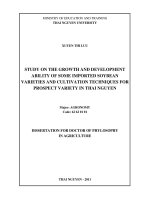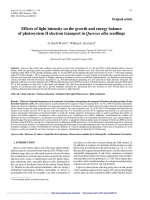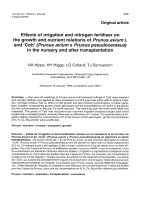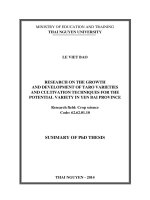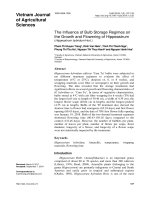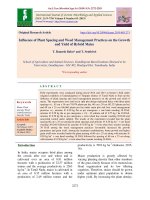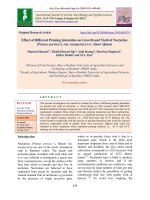Effect of different substrates on the growth and yield of Milky mushrooms in Telangana, India
Bạn đang xem bản rút gọn của tài liệu. Xem và tải ngay bản đầy đủ của tài liệu tại đây (149.55 KB, 4 trang )
Int.J.Curr.Microbiol.App.Sci (2019) 8(5): 335-338
International Journal of Current Microbiology and Applied Sciences
ISSN: 2319-7706 Volume 8 Number 05 (2019)
Journal homepage:
Original Research Article
/>
Effect of Different Substrates on the Growth and
Yield of Milky Mushrooms in Telangana, India
M. Prameela* and G. Uma Devi
Mushroom Cultivation Scheme, Department of Plant Pathology, College of Agriculture,
PJTSAU, Rajendranagar, Hyderabad- 500 030, India
*Corresponding author
ABSTRACT
Keywords
Substrate, Growth,
Yield, Milky
mushroom and
Calocybe indica
Article Info
Accepted:
04 April 2019
Available Online:
10 May 2019
Performance of milky mushroom (Calocybe indica) on different agricultural wastes like
paddy straw, castor stalks, sunflower stalks, coconut coir pith, oil palm waste and
groundnut shells was evaluated during the summer season. The spawning was done by
sterilization of all the seven substrates. The bags were kept in spawn running room with
the maintenance of temperature (30°C–35° C) and relative humidity (70–80 %)
respectively. The minimum number of days required for completion of spawn run (30
days), primordial formation (10-15 days) and days for first harvest (40–45 days) was
recorded with the paddy straw substrate followed by castor stalks where the minimum
number of days required for completion of spawn run (33 days), primordial formation (10–
15 days) and days for first harvest (43–48days). The experimental results revealed that
paddy straw substrate was best and recorded an average yield of 1.0 to 1.5 kg per bed as
compared to the other substrates. After paddy straw, the yield of milky mushrooms on
coconut coir pith (806 g/ kg substrate) and oil palm waste (830 g/ kg substrate) was found
on par with each other and yielded more compared to other substrates. Mushroom growers
can adopt paddy straw substrate for growing milky mushrooms during summer season.
The relative efficacy of the agricultural by-products analysed in the study indicated that
paddy straw substrate is suitable for cultivation of milky mushrooms.
of West Bengal. The fruiting bodies are
attractive with thick fleshy, white cap and
thick stalk. The mushrooms have better shelf
life as compared to oyster and button
mushroom and thereby there is no browning
on storage. It requires temperatures of 30 35°c for growth and fructification, hence
highly suitable for tropical climate. With the
depletion of water resources and introduction
of WTO regime, cropping pattern is changing
Introduction
Calocybe indica is the second important
commercially grown mushroom in Telangana
after button mushroom. Ever increasing
production in mushroom like Calocybe indica
pose challenge to the current supremacy of
button mushroom in the world market (Miller,
1994). It is tropical species which recently
was collected and consumed from the forests
335
Int.J.Curr.Microbiol.App.Sci (2019) 8(5): 335-338
very rapidly, farmers are going for
commercial ID crops and information on the
utilization of the by-products of these crops is
lacking, so there is need to evaluate the byproducts of different crops and to bring
awareness among the growers about the
utilization of the various crop by- products as
substrates in mushroom cultivation. Milky
mushroom can be cultivated on varieties of
cellulosic substrates like, paddy straw, wheat
straw, maize stalks, sorghum stalks, pearl
millet stalks, sugarcane trace, sugarcane
baggase, soya bean straw, cotton waste,
coconut coir pith, groundnut haulms etc.
Substrate preparation
The present investigation was taken up to
evaluate the effect of seven different
substrates on growth and yield of milky
mushrooms during summer season.
Casing material
The substrate such as paddy straw, castor
stalks, sunflower stalks, soybean hulls,
coconut coir pith, oil palm waste and
groundnut shells were chopped into 2 to 3
inch pieces and soaked in fresh water for 68hrs and sterilized in hot water for 2 - 3hrs.
After that, the substrate was taken out and
substrate is dried till it contains 60-70%
moisture. Spawning was done @ 4 percent by
wet weight of the prepared substrate.
Cultivation was done in polythene bags of
100 gauge thickness (Pani and Das, 1998).
Casing mixture was prepared by using black
or red soil and pH was adjusted to 8.0 by
using CaCo3 or CaSo4. The mixture was
treated with 4% formalin solution and
covered with plastic sheet for 72 hrs.
Thickness of casing material was maintained
about 3.0 cm.
Materials and Methods
Pure culture and spawn preparation
The seeds of mushroom are known as spawn.
Tissue from mature fruiting body was
aseptically placed on Potato dextrose agar
medium in Petri plates and placed in the
incubator at 25± 2̊ C for one week . This pure
culture was transferred into PDA slants and
used to make commercial spawn. Spawn
preparation was done by using standard
method described by Krishnamoorthy (2003).
Method starts with boiling of healthy and
clean sorghum grain until it absorb water and
get double in size. It is then allowed to cool
and excess water was removed. Grains are
mixed with calcium carbonate 20g per kg
grains and calcium sulphate 5g per kg grains
in order to prevent aggregation and to
maintain required pH. Non absorbent cotton
was plugged and autoclaved at 15 p.s.i for 1.5
to 2 hrs. It was inoculated after cooling and
incubated at 23 ± 2̊ C for 15 to 20 days. As
the grain fully covered with mycelium it is
ready for spawning the substrate.
The experiment was laid out as completely
randomized design with five replication and
seven treatments.
Results and Discussion
Among the seven substrates evaluated for the
performance of Calocybe indica, it was
recorded that among all the substrates paddy
straw was high and recorded an average yield
of 1.0 to 1.5 kg per bed as compared to the
other substrates which was used as a check.
Time taken for the mycelium to cover the bed
is about 30days and mushrooms developed 10
- 15 days after application of casing material
either sterilized black or red soil. After paddy
straw, the yield of milky mushrooms on two
substrates coconut coir pith (806 g/ kg
substrate) and oil palm waste (830 g/ kg
substrate) was found on par with each other
and yielded more compared to other
336
Int.J.Curr.Microbiol.App.Sci (2019) 8(5): 335-338
substrates. A maximum period of 43 days was
taken for the completion of mycelial growth
in the substrates soybean hulls and coconut
coir pith. Minimum yield was recorded in
sunflower stalks (410g/ kg substrate). The
relative efficacy of the agricultural byproducts analysed in the study indicated that
paddy straw substrate is suitable for
cultivation of milky mushrooms. Tewari
(1991) provided an evidence for relationship
between spawn rate and sporophore yield in
Pleurotus sajor-caju which implied that 4%
and 6% of spawn on wet weight basis have
enhanced maximum sprophore yield during
summer and winter season respectively.
Similarly, Calocybe indica yielded more at
4% spawn rate (Doshi et al., 1993). In the
present experiment paddy straw found to be a
good substrate for cultivation of milky
mushroom which is in agreement with earlier
reports of several scientists (Fig. 1 and Table
1).
Table.1 Effect of different substrates on the growth and yield of milky
mushrooms in summer season
S.No.
1
2
3
4
5
6
7
Name
of
substrate
the Time taken for
the mycelium to
cover the bed
Castor stalks
33
Sunflower stalks
37
Soybean hulls
43
Coconut coir pith
43
Oilpalm waste
38
Groundnut shells
36
Paddystraw(check) 30
CD(0.05)
CV(%)
Time taken for the
mushroom to develop
after casing (Days)
10-15
10-20
15-20
15-25
15-20
15-20
10-15
Yield (g) /kg of
substrate
613
410
693
806
830
630
1400
43.8
3.2
Fig.1 Effect of different substrates on the growth and yield of milky
mushrooms in summer season
337
Int.J.Curr.Microbiol.App.Sci (2019) 8(5): 335-338
Highest yield performance of milky
mushroom was observed by Krishnamoorthy
and Muthusamy (1997), Biswas and Singh et
al., (2009), Pani (2010) and Saranya et al.,
(2011) who had reported that paddy straw was
the best substrate for cultivation of C. indica.
(1993). A promising edible mushroom
for the tropics: Calocybe indica.
Mushroom Information, 5: 14-22.
3.Krishnamoorthy A.S. and Muthusamy M.
(1997). Yield performance of C.
indica (P&C) on different substrates.
Mushroom Res., 6: 29-32
Krishnamoorthy A. S. (2003). Commercial
prospects of milky mushroom
(Calocybe indica) in the tropical
plains of India. In: current vistas in
mushroom biology and production.
Mushroom Society of India. 131-135.
Miller F. C. (1994). World trade in
mushroom. In souvenir National
Symposium on mushroom, NCMRT,
Solan, India. 56-62.
Pani B. K. and Das S. R. (1998). Seasonal
productivity of white summer
mushroom (Calocybe indica P. & C.)
in Orissa. Science and Culture. 64:
177-178
Pani B. K. (2010). Optimal In vitro
environmental condition for the
growth of white summer mushroom
(Calocybe indica). Research Journal
of Agricultural Sciences. 1: 280-281.
Saranya V., Madhanraj P. and Panneerselvam
A. (2011). Cultivation, composting,
biochemical
and
molecular
characterization of Calocybe indica (C
and A). Asian J. Pharm. Res., 3: 55-57
Tewari R. P., (1991). Effect of soaking period
and spawn dose on oyster mushroom
(Pleurotus sajor-caju) production. In
Indian Mushrooms (Eds.) M.C. Nair,
KAU, Vellanikkare.
In conclusion, the result shows that the paddy
straw substrate is highly suitable for
cultivation of milky mushrooms in Telangana.
Mushroom growers can adopt paddy straw
substrate for growing of milky mushrooms
during summer season.
The result also shows that cultivation of
Calocybe indica mainly depend on the
substrate on which it is cultivated and varied
production potential of different substrates is
due to the variations in their physical
properties and nutritional composition.
Keeping in view the present scenario in
climatic changes it is very difficult to farmers
to relay on Agriculture alone. In such
circumstances farmers can taken up milky
mushroom cultivation as small cottage
industry with low investment which also
provides employment to unemployed youth
and rural women and help in reaping profits
in short period of time.
References
Biswas S. and Singh N. P. (2009). Evaluation
of alternative substrate for milky
mushroom. J. Mycol. Pl. Pathol., 39:
355-357.
Doshi A., Sharma S. S. and Trivedi A.,
How to cite this article:
Prameela, M. and Uma Devi, G. 2019. Effect of Different Substrates on the Growth and Yield
of Milky Mushrooms in Telangana. Int.J.Curr.Microbiol.App.Sci. 8(05): 335-338.
doi: />
338
